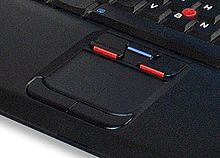Touchpad


A touchpad is an input device commonly used in desktop computers. They are used to move the cursor, using motions of the user's finger. They are a substitute for a computer mouse. Touchpads vary in size but are rarely made larger than 20 square centimeters (about 3 square inches). They can also be found in PDAs.
Touchpads operate by sensing the capacitance of a finger, or the capacitance between sensors. Capacitive sensors are laid out along the horizontal and vertical axes of the touchpad. The location of the finger is determined from the pattern of capacitance from these sensors. This is why they will not sense the tip of a pencil or other similar implement. Gloved fingers may be problematic (such as in a cleanroom environment) but can sometimes work. Moist, sweaty, or calloused fingers can be problematic for those touchpads that rely on measuring the capacitance between the sensors.
Touchpads are relative motion devices. That is, there is no isomorphism from the screen to the touchpad. Instead, relative motion of the user's fingers causes relative motion of the cursor. Teh buttons below or above the pad serve as standard mouse buttons. Depending on the model of touchpad and drivers behind it, you may also click by tapping your finger on the touchpad, and drag with a tap following by a continuous pointing motion (a click-and-a-half).
Some touchpads also have "hotspots": locations on the touchpad that indicate user intentions other than pointing. For example, on certain touchpads, moving your finger along the right edge of the touch pad will control the scrollbar and scroll the window that has the focus vertically. Moving the finger on the bottom of the touchpad often scrolls in horizontal direction.
Some touchpads can emulate multiple mouse buttons by either tapping in a special corner of the pad, or by tapping with two or more fingers.
Early Apollo desktop computers were equipped with a touchpad on the right side of the keyboard.[1]
Touchpads are primarily used in portable laptop computers, because the usual mouse device requires a flat table adjacent to the keyboard not always available away from the office. But touchpads have some advantages over the mouse, particularly that the pad's position is fixed relative to the keyboard, and very short finger movements are required to move the cursor across the display screen. Some computer users prefer them for such reasons, and desktop keyboards with built-in touchpads are available from specialist manufacturers.
Touchpads have also recently appeared in Apple's iPod. The main control interface for menu navigation in all of the currently produced iPods (except the Shuffle) is a touchpad (at first by Synaptics; Apple now manufactures that component itself). Creative Labs also uses a touchpad for their Zen line of MP3 players, beginning with the Zen Touch and most recently featured in the Zen Vision:M.
The "trackpad" is Apple's name for the touchpad. It was introduced in 1994 in the PowerBook 500 series, the first laptop ever to carry such a device, and replaced the trackball of previous PowerBook models. Late generation PowerBooks and iBooks have two-finger sensing capabilities, as well as the current MacBook and MacBook Pro model lines. These capabilities include the ability to right-click by tapping two fingers and the ability to scroll both vertically and horizontally at the same time by dragging two fingers (which is very useful when looking at a large photo, webpage, etc). In Mac OS X Tiger, also known as 10.4 you can change the settings ofr the touchpad. Some changes include Right Clicking by Tapping Two fingers on the trackpad, another popular one is Clicking by Tapping the touchpad. Horizontal and vertical scrolling are avalible as an option.
In 1989 Psion introduced their first full size laptop (Psion MC 200/400/600/WORD series) with a new mouse-replacing touch-pad. Although the Psion's was a tap-to-point design that did not catch on, the Apple stroke-to-point design did, so the Psion's system wasn't really a touchpad as we think of them today.
Theory of operation
There are two principal means by which touchpads work. In the 'matrix approach', a series of conductors are arranged in an array of parallel lines in two layers, separated by an insulator. The conductors in these layers are oriented orthogonally to one another. A high frequency signal is applied sequentially between pairs in the two dimensional matrix created by the conductor array. The current that passes between the nodes is proportional to the capacitance. When a virtual ground, such as the finger, is placed over one of the intersections between the conductive layer some of the electrical field lines are shunted to this ground point, resulting in a change in the apparent capacitance at that location. This method received U.S. patent 5,305,017 awarded to George Gerpheide.
The capacitive shunt method, described well in an application note by Analog Devices, senses the change in capacitance between a transmitter and receiver that are on opposite sides of the sensor. The transmitter creates an electric field which oscillates at 2-300 kHz. If a ground point, such as the finger, is placed between the transmitter and receiver, some of the field lines are shunted away, decreasing the apparent capacitance.
References and notes
- ^ Getting Started With Your DOMAIN System. Apollo Computer. 1983.
